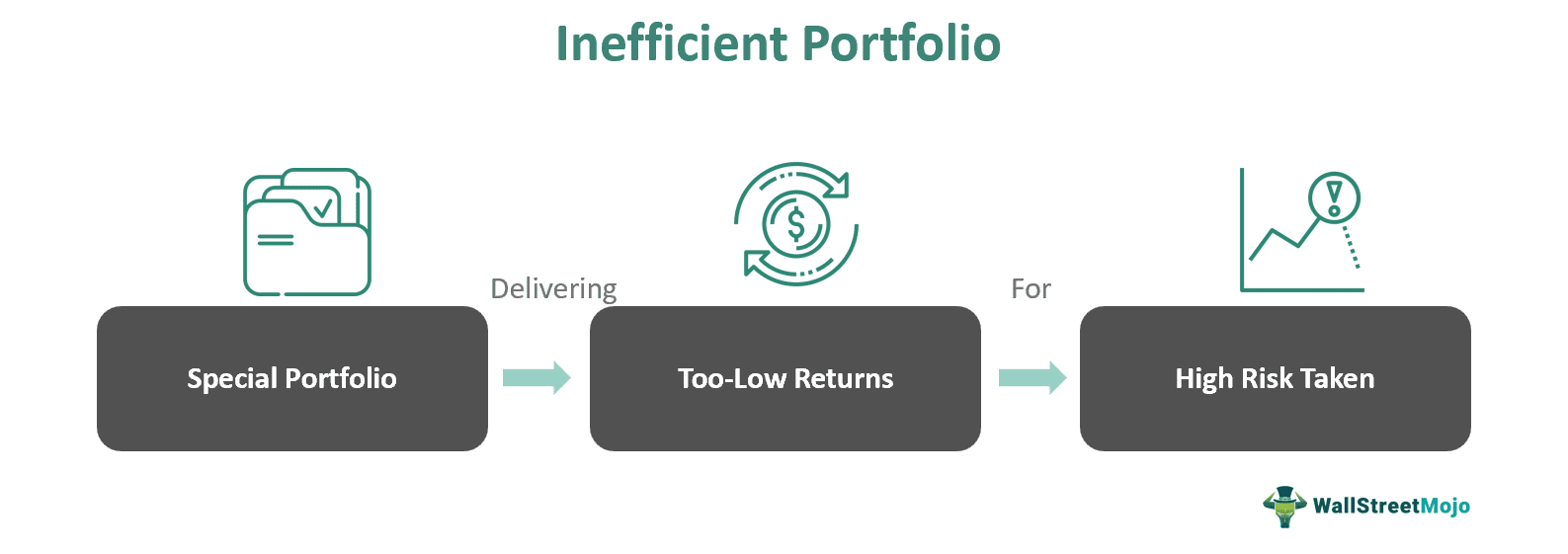Table Of Contents
What Is An Inefficient Portfolio?
An inefficient portfolio refers to a category of portfolio delivering a too-low expected return on investment for the degree of risk the investor takes. It offers a poor risk-to-reward ratio because of either a lower return per risk taken or excessive risk-taking to achieve a particular return objective.

It can be represented graphically as a portfolio deviating too much from the efficient frontier. It contains a single portfolio within the mean-variance rule that dominates the bundle of assets. It lacks possible diversification to mitigate risk and increase return on investment so many investors avoid it commonly.
Key Takeaways
- An inefficient portfolio can be identified as a type of portfolio that grants back the expected return of investment badly compared to the level of risk one agrees to take on.
- It has a high risk-reward ratio, either by giving a lower return than the risk taken or by increasing risk to reach a particular return objective significantly.
- It cannot achieve the expected level of returns for the taken risk, while an efficient portfolio achieves the maximum desired level of return for the taken risk.
Inefficient Portfolio Explained
An inefficient portfolio definition can be stated as a portfolio with the same amount of risk. Still, the expected rate of return is higher as compared to the first portfolio. Here the portfolio does not align with principles of modern portfolio theory (MPT) like the efficient frontier. MPT theory states that a portfolio must try to achieve the highest expected return for a given level of risk by balancing the highest level of risk with the highest potential returns. Such an ineffective portfolio fails to strike the desired level of balance between return and risk.
These portfolios have remained inferior to efficient portfolios because these portfolios may lose out on gains or expose investors to unnecessary risks. As a result, it has become less attractive to rational investors having the objective of optimal returns for a given level of risk. It can impact the financial world on a broad spectrum as follows;
- If a market mostly consists of inefficient portfolios, it might lead to opportunities for arbitrage.
- In such a scenario, investors can leverage the price discrepancies to earn abnormal returns.
- It may contribute to market volatility because they can amplify price changes owing to their misaligned behavior with the efficient frontier.
In conclusion, portfolios lacking efficiency deviate from the main principles of the modern portfolio theory and decrease the efficiency ratio of risk and return.
Examples
Let us use a few examples to understand the topic.
Example #1
As an imaginary example, a portfolio manager named Noah has diversified assets. The portfolio in question contains two assets: A and B. It is evident that asset A has a higher volatility and a lower return rate than B. Applying the mean-variance rule, asset A is dominated by asset B. However, the whole portfolio turns out to be inefficient without optimal risk and return trade-off.
This inefficiency occurs because an asset dominates the portfolio. What Noah can do here is identify the inefficiency in the portfolio and reallocate some of the investments from A to B. By doing this, he can work towards constructing a more effective and balanced portfolio in accordance with the mean-variance theory for a better risk-adjusted return.
Example #2
In an article published on December 1, 1996, the superiority of the 100% equity investment portfolio over an investor's portfolio with 60% equities and 40% bonds (60/40) is questioned. In a 1994 article, Richard H. Thaler and J. Peter Williamson argued that investing in 100% equities is superior to a common investment method of 60% equities and 40% bonds (60/40). However, their recommendation to endowments to invest in 100% equities combines two different ideas:
- Endowments should have a higher equity ratio than 60/40, and
- They should increase their equity exposure by investing the entire portfolio in equities.
In contrast, the article suggests that the above recommendation of a 100% equity portfolio ignores diversification's potential advantages and does not represent the lowest risky asset allocation. Also, diversified portfolios have the potential to yield a higher return and not increase the risk involved. Therefore, going with an equity portfolio comprising of historical realized returns is ignoring the fact that the movements in the market are not random. Hence, it can be said that a 100% equity portfolio is almost an inefficient portfolio.
Difference Between Inefficient and Efficient Portfolio
Both have different abilities to handle risk and return successfully, as underlined in the table below;
| Inefficient Portfolio | Efficient Portfolio |
|---|---|
| Cannot achieve the expected level of returns for the taken risk | Achieves the maximum desired level of return for the taken risk |
| Has a higher degree of risk associated with the returns generated | Maximizes returns while minimizing risks |
| Does not have diversification of assets, leading to losses and missed growth opportunities. | Optimally diversified for reducing market risk impact |
| Has either too many risky or poor-performing assets | Best mis of assets to achieve maximum efficiency |
| Performs sub-optimally, having lower returns and higher risk than expected | Its risk-adjusted returns performance is superior |
| Tends to amplify market volatility by creating a misaligned efficient frontier. | Its efficient portfolio allocation contributes toward market stability |
| Investors going for maximum risk-return trade-off avoid it | Rational investors desirous of maximum gains at certain risk levels prefer it. |
| This opens up opportunities for arbitrage in the market due to mispricing. |

